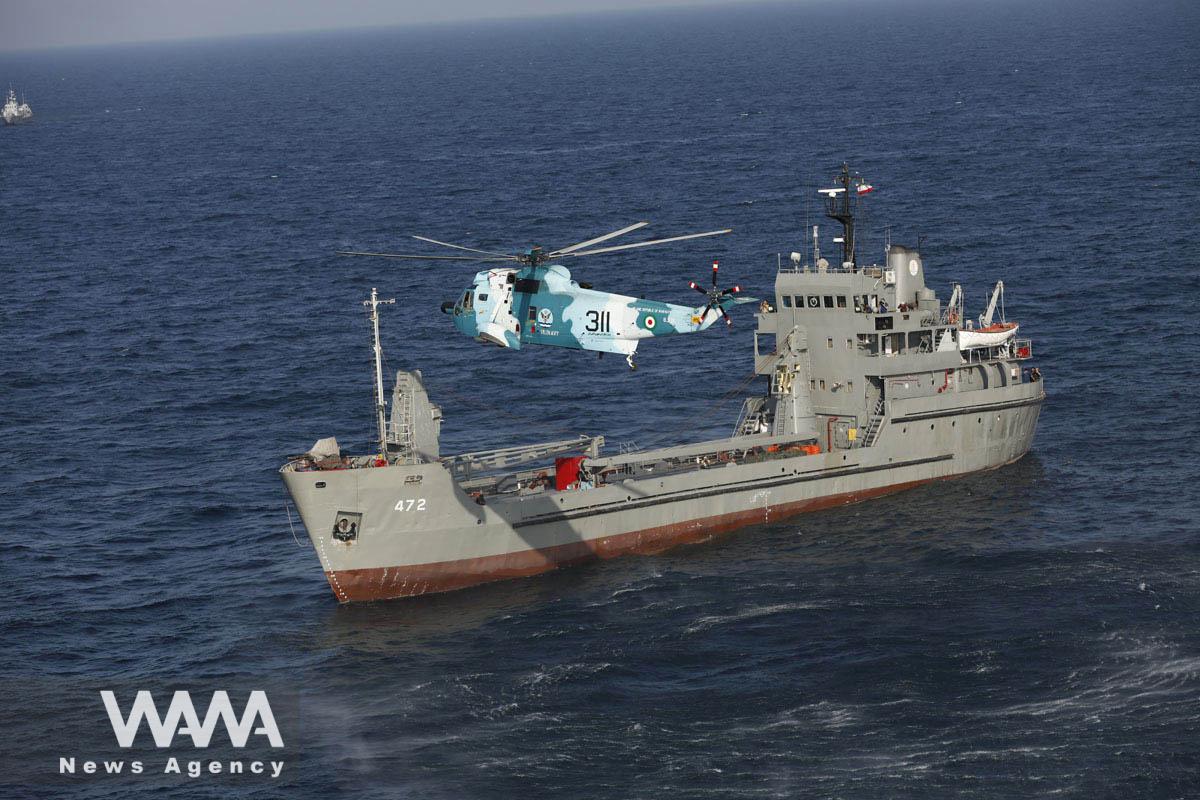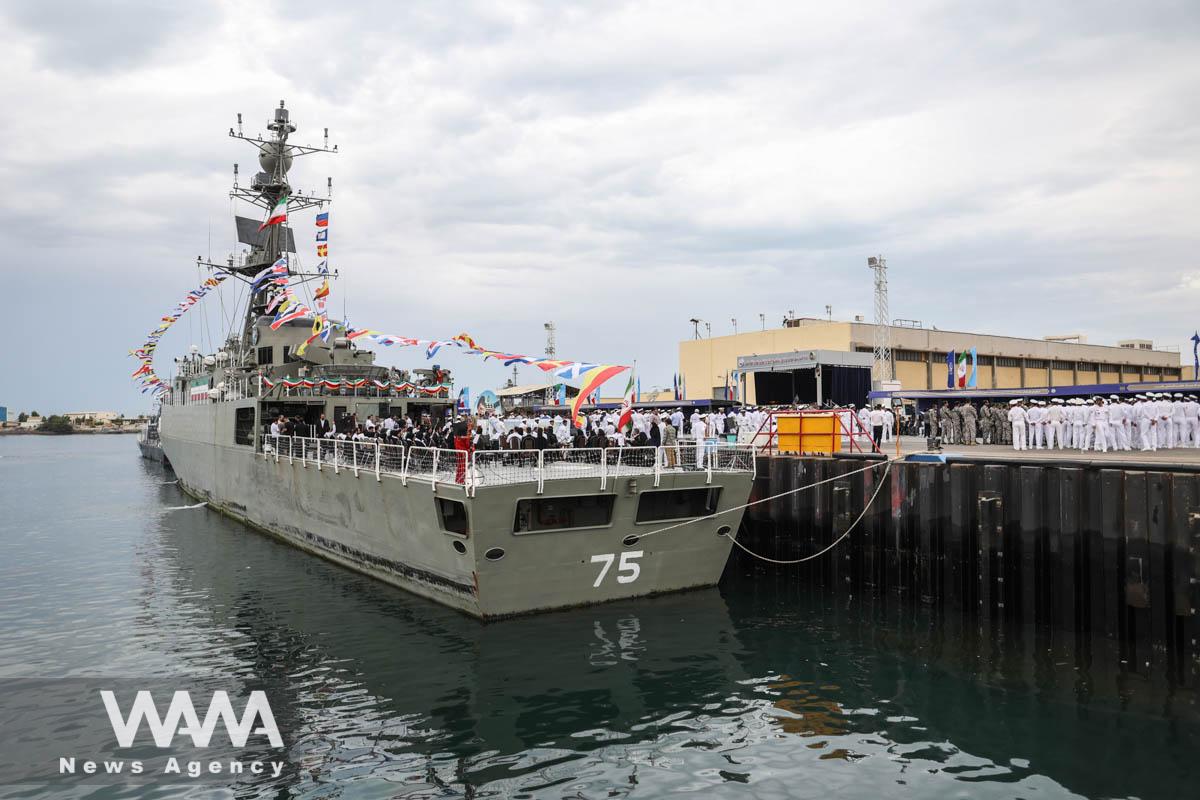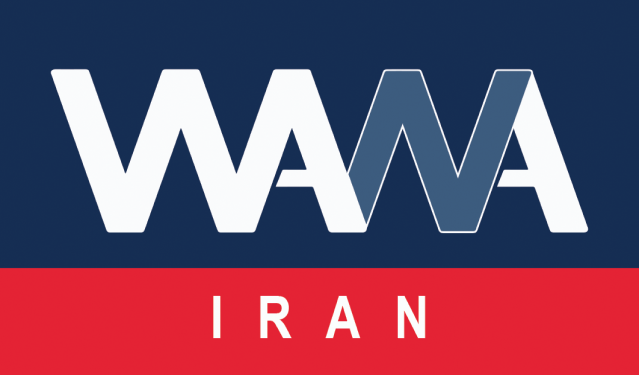Iranian Navy’s 100th International Mission
WANA (Feb 18) – Fifteen years after the Jamaran destroyer was commissioned into the Iranian Navy, the force has built several more destroyers and completed 100 missions in international waters.
The Beginning of Jamaran
The Jamaran destroyer officially joined the Iranian Navy on February 19, 2010, in a ceremony attended by the Commander-in-Chief. Its construction had begun in 1997 as part of the Mowj-class project, marking a turning point in Iran’s capability to manufacture destroyers domestically.
With a length of 94 meters and a displacement of approximately 1,500 tons, Jamaran can accommodate 120 to 140 crew members and reach speeds of 30 knots. It is also equipped to carry a helicopter.
Jamaran features advanced radar processing systems, tactical air, surface, and subsurface radars, electronic warfare systems, fire control systems, and a range of combat and defense capabilities that have been upgraded over time. It is armed with anti-ship and surface-to-air missiles, torpedoes, and naval guns, including the Fajr series.

Iran and Pakistan Strengthen Naval Operational Capabilities
WANA (Feb 08) – Admiral Shahram Irani, Commander of the Islamic Republic of Iran Navy, arrived in Karachi on Saturday to participate in the multinational naval exercise “Aman-25” at the invitation of the Pakistan Navy. Highlighting the importance of close ties with Pakistan, Admiral Irani stated that Iran’s participation at the highest level in […]
Jamaran’s Latest Mission
In its most recent mission in February 2024, Jamaran participated in the “AMAN 25” naval exercise held in the waters off Karachi, Pakistan. The drill involved naval fleets, aircraft, and special maritime forces from over 60 countries.
Expanding the Fleet
Over the years, the Iranian Navy has continued to expand its fleet beyond Jamaran. It commissioned the Damavand destroyer in 2014, Sahand in 2018, an upgraded Alborz in 2019, Dena in 2021, an upgraded Alvand in 2021, Deylaman in 2023, and Zagros in 2024. Each of these destroyers has enhanced the Navy’s operational capabilities.
Rear Admiral Amir Rastegari, CEO of Iran’s Electronic Industries Company, highlighted the progress made in naval technology over the past 15 years: “Our capabilities have significantly advanced since 2010 when Jamaran was commissioned. Globally, naval platforms are retained while their systems are upgraded. The radars on our vessels today are phased-array with long-range, high-precision targeting capabilities. Our electronic warfare, intelligence, communications, fire control, and missile systems have seen exponential improvements in accuracy, range, and speed. We are among the top naval powers in the region and one of the few globally that develops its own equipment domestically.”
He further emphasized the significance of the all-Iranian Dena destroyer, which led the Navy’s 86th flotilla in a world tour, covering over 55,000 kilometers across five oceans.
According to Rastegari, Iran has localized the production of various naval platforms, including missile-launching ships and submarines up to 600 tons. The recently unveiled Zagros destroyer is the latest addition, with more vessels under development.
Naval Exports and Self-Sufficiency
Regarding Iran’s ability to export naval technology, Rastegari stated: “We have the capacity to export heavy vessels up to 1,500 tons, hovercraft, high-speed boats, and submarines up to 600 tons. Negotiations are underway with friendly nations, and some of our naval assets have already been exported. Sanctions did not stop us; instead, we strengthened our defense capabilities, meeting the needs of our forces and allies. These exports generate revenue, create jobs, and enhance the quality of our products.”

An Iranian warship takes part in a joint naval military drill between Iran, Russia, and China in the Gulf of Oman, Iran, in this picture obtained by Reuters on March 18, 2023. Iranian Army/WANA (West Asia News Agency)
Presence in International Waters
The Navy’s operational advancements have allowed it to expand international missions. Its first such mission dates back to 2008, when Iranian warships were deployed to the northern Indian Ocean, the Bab el-Mandeb Strait, the Gulf of Aden, and the Red Sea. Today, Iran’s 100th naval flotilla is patrolling international waters, comprising the Bushehr combat support ship and the Lavan logistics vessel in the northern Indian Ocean and the Gulf of Aden.
This region is a crucial maritime corridor, handling nearly 50% of container trade and 70% of global oil shipments. The annual trade volume passing through the Indian Ocean exceeds $1 trillion, with a third of global maritime commerce occurring in these waters.
However, instability in Sudan and the resurgence of piracy in the Red Sea, Gulf of Aden, Bab el-Mandeb Strait, and even the Indian Ocean have posed new security threats. Former Somali military personnel have joined pirate groups, increasing the risk of hijackings targeting commercial vessels.
Iran’s Navy has been present in the region since 2008, escorting Iranian and foreign ships and engaging in multiple confrontations with pirates. According to Rear Admiral Habibollah Sayyari, deputy coordinator of the Iranian Army: “Between 2008 and 2022, nearly 5,000 commercial and oil tankers were protected by the Iranian Navy through escort teams and deployed destroyers, ensuring their safe passage through piracy-prone waters.”
Beyond the Indian Ocean
The Iranian Navy has expanded its operations far beyond the Indian Ocean, conducting missions in the Pacific, docking in China, transiting the Suez Canal into the Mediterranean, circumnavigating Africa, and reaching the Atlantic and Russia’s Saint Petersburg. The latest multinational naval exercise, “AMAN 25,” in Pakistan saw active Iranian participation.

Dena battleship is seen during the welcome ceremony of the army fleet members in Bandar Abbas, Iran, May 21, 2023. Majid Asgaripour/WANA (West Asia News Agency)
The 86th Flotilla’s Historic Voyage
Among its many missions, the 86th flotilla’s global circumnavigation stands out as a major milestone.
The flotilla, comprising the Dena destroyer and the Makran forward base ship, set sail from Bandar Abbas in September 2023. Over 220 days, it traveled 65,000 kilometers, crossing major global waterways.
After departing Bandar Abbas, the flotilla reached Mumbai, India, and later Jakarta, Indonesia, after navigating the Malacca Strait. It then crossed the Pacific Ocean, passed through French Polynesia (sparking protests from France), and rounded the southern tip of South America via the Magellan Strait.
Upon entering the Atlantic, the ships docked in Rio de Janeiro, Brazil, before crossing the ocean to Cape Town, South Africa, and Dar es Salaam, Tanzania. The flotilla then reentered the Indian Ocean, patrolled the Gulf of Aden, made a stop in Oman’s Salalah port, and finally returned to Bandar Abbas.
Future Plans
Iran’s naval ambitions continue to grow, with ongoing projects including submarines, destroyers, missile boats, support vessels, helicopters, hovercraft, and coastal missile systems. The latest destroyer under construction is named “Taftan.”
Rear Admiral Shahram Irani, commander of the Iranian Navy, has also announced plans for a permanent presence in international waters and future scientific missions to Antarctica.












